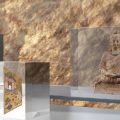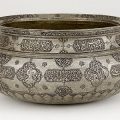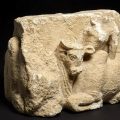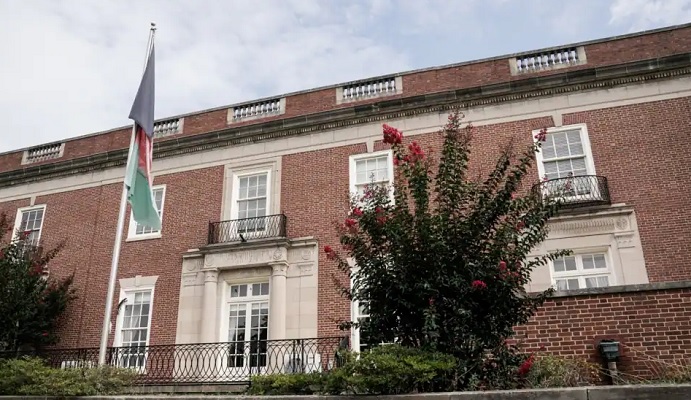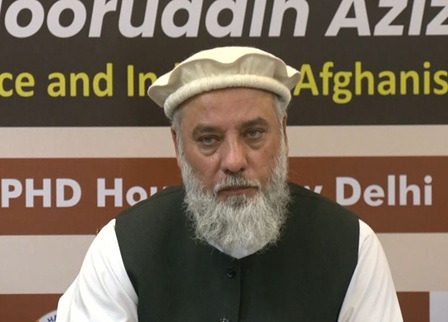
It is quite a surprise when a renowned museum chooses to marshal its resources to help benefit a worthy non-profit organization; and this is exactly how your correspondent found herself — surprised — to discover that the Smithsonian’s Sackler Gallery had opened a section of its museum to replicate the vibrant marketplace of Old Kabul.
The transformation is further enhanced with onsite Afghan artisans demonstrating their skills in jewelry making, wood carving and jali shades, calligraphy, ceramics, carpets, ceramics, emerald and gold jewelry, gem cutting, miniature paintings, and yes, even homemade kites sailing across the ceiling of the exhibition.
The Sackler’s “immersive exhibition” depicts Murad Khani, the cultural center of Old Kabul. This idea of the Smithsonian’s interactive ‘souk’ is in tribute to Turquoise Mountain Trust, a non-profit, non-governmental foundation created in 2006 with the aim of regenerating historic areas, preserving and transmitting traditional craft skills, and creating jobs.
Ferozkoh means “Turquoise Mountain,” in both Dari and Pashto, Afghanistan’s key languages, and it once was the cosmopolitan and lost-lost capital of central Afghanistan’s 12-century Ghorid Dynasty.
“This is … meant to transcend the headlines of war and conflict,” said Julian Raby, the director of the Smithsonian Institution’s Sackler Gallery of Art. “This exhibition highlights the vitality of these new Afghan artisans and demonstrates the power of art and culture to tell the story of artistic creativity, resilience and hope.”
Afghanistan, it often is too easy to forget due to the devastation it has endured through recent wars, was located at the heart of ancient Silk Road trade routes; and for more than 3,500 years it absorbed the cultures and traditions of India, Persia and Central Asia.
These decades of civil unrest that began in the 1970s nearly destroyed this vital heritage. Artisans often were forced to leave their country or abandon their crafts. Murad Khani, once the bustling center of craft and commerce in Afghanistan’s largest metropolis — collapsed into ruin.
The Turquoise Mountain Trust was founded in 2006 when British author and politician Rory Stewart established the trust with the support of England’s Prince Charles, and Hamid Karzai, the then-president of Afghanistan. In just ten years, they have revitalized the Murad Khani district of Old Kabul from slum conditions into a vibrant cultural and economic center, while training more than 450 male and female artisans since its founding eight years ago.
Its success on the ground has won world-wide recognition. Prince Alwaleed bin Talal, for example, has given his support to the project. Its calligraphy school is named after him — the Alwaleed Bin Talal School of Calligraphy and Miniature Painting. Prince Alwaleed “strongly believes in the power and value of preserving and reviving the Islamic arts across the world,” said Dr. Tommy Wild, Director of Exhibitions with Turquoise Mountain Trust. “This has resulted in the Middle East and Afghanistan collaborating and exchanging ideas and support.”
The organization also has invested back by aiding the local community: it has renovated historic buildings, opened a primary school and a medical clinic which serves 18,000 patients per year, and rebuilt necessary infrastructure. Equally important, it has founded Afghanistan’s premier institution for vocational training in the arts which is dedicated to teaching a new generation of Afghan artisans.
Turquoise Mountain is succeeding in reviving the nation’s proud cultural legacy by providing on-the-job training in traditional construction techniques to over 1,000 masons, carpenters, and laborers during the restoration of Murad Khani; the project’s workers have also cleared 30,000 cubic meters of rubbish from the streets, rebuilt or restored 112 historic and community buildings using traditional earth construction techniques and provided water, electricity, and sanitation to the old city.
The Smithsonian’s Sackler Turquoise Mountain exhibition, made possible by the support given through the United States Agency for International Development (USAID), conjures up the unexpected throughout the exhibit.
Here you will find a caravanserai — a courtyard that once served as a gathering and resting place for Silk Road travelers — which was recreated by shipping from Afghanistan more than three tons of hand-carved Himalayan cedar. It includes two 30-foot colonnaded arches and artisan stalls, embellished with colorful toshaks, or Afghan cushions. Visitors are invited to sit and explore with onsite interactive touchscreen maps of Afghanistan which allows visitors to explore the history of the region and better learn of its artistic traditions.
Throughout the duration of the Sackler Gallery’s Turquoise Mountain exhibition, which closes in January 2017, Afghan artisans will travel to Washington and share their skills and traditions with museum visitors. Seventeen visiting Afghan artisans, many of whom are teachers and young entrepreneurs, will showcase their talents to visiting public guests.
And, as an ultimate compliment to their hard work to maintain their heritage, Turquoise Mountain’s artisans have gained worldwide recognition for their beautiful creations. Major international exhibitions have been organized to display their work including the Venice Biennale and the Museum of Islamic Art in Doha. The Trust has also established partnerships with prestigious international retailers from Bloomingdales and Kate Spade in New York, to Pippa Small and Monsoon-Accessorize in London.
For more information log onto: asia.si.edu/turquoisemountain.
Courtesy: Arab News
